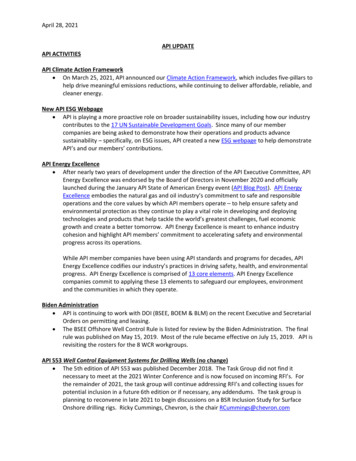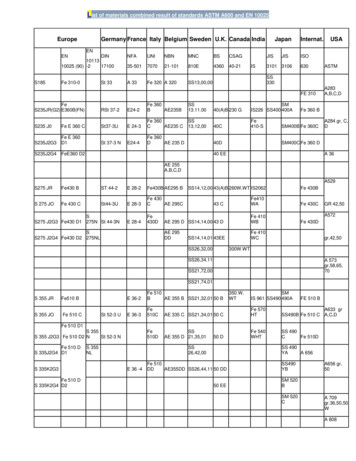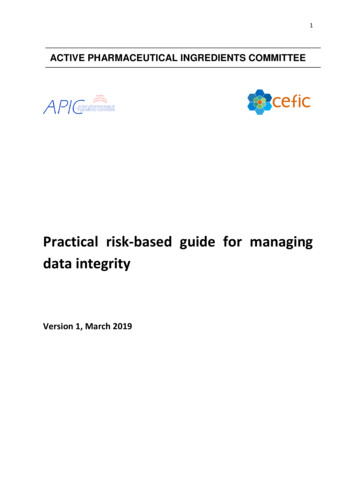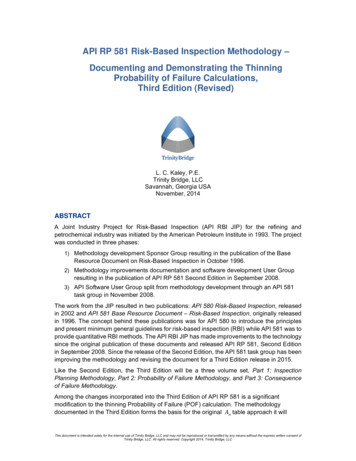
Transcription
API RP 581 Risk-Based Inspection Methodology –Documenting and Demonstrating the ThinningProbability of Failure Calculations,Third Edition (Revised)L. C. Kaley, P.E.Trinity Bridge, LLCSavannah, Georgia USANovember, 2014ABSTRACTA Joint Industry Project for Risk-Based Inspection (API RBI JIP) for the refining andpetrochemical industry was initiated by the American Petroleum Institute in 1993. The projectwas conducted in three phases:1) Methodology development Sponsor Group resulting in the publication of the BaseResource Document on Risk-Based Inspection in October 1996.2) Methodology improvements documentation and software development User Groupresulting in the publication of API RP 581 Second Edition in September 2008.3) API Software User Group split from methodology development through an API 581task group in November 2008.The work from the JIP resulted in two publications: API 580 Risk-Based Inspection, releasedin 2002 and API 581 Base Resource Document – Risk-Based Inspection, originally releasedin 1996. The concept behind these publications was for API 580 to introduce the principlesand present minimum general guidelines for risk-based inspection (RBI) while API 581 was toprovide quantitative RBI methods. The API RBI JIP has made improvements to the technologysince the original publication of these documents and released API RP 581, Second Editionin September 2008. Since the release of the Second Edition, the API 581 task group has beenimproving the methodology and revising the document for a Third Edition release in 2015.Like the Second Edition, the Third Edition will be a three volume set, Part 1: InspectionPlanning Methodology, Part 2: Probability of Failure Methodology, and Part 3: Consequenceof Failure Methodology.Among the changes incorporated into the Third Edition of API RP 581 is a significantmodification to the thinning Probability of Failure (POF) calculation. The methodologydocumented in the Third Edition forms the basis for the original Art table approach it willThis document is intended solely for the internal use of Trinity Bridge, LLC and may not be reproduced or transmitted by any means without the express written consent ofTrinity Bridge, LLC. All rights reserved. Copyright 2014, Trinity Bridge, LLC
replace. This paper provides the background for the technology behind the thinning modelas well as step-by-step worked examples demonstrating the methodology for thinning in thisnew edition of API RP 581. This paper is a revision to a previous publication: API RP 581Risk-Based Inspection Methodology – Basis for Thinning Probability of Failure Calculationspublished in November 2013.This document is intended solely for the internal use of Trinity Bridge, LLC and may not be reproduced or transmitted by any means without the express written consent ofTrinity Bridge, LLC. All rights reserved. Copyright 2014, Trinity Bridge, LLC
1.0INTRODUCTIONInitiated in May 1993 by an industry-sponsored group to develop practical methods forimplementing RBI, the API RBI methodology focuses inspection efforts on process equipmentwith the highest risk. This sponsor group was organized and administered by API and includedthe following members at project initiation: Amoco, ARCO, Ashland, BP, Chevron, CITGO,Conoco, Dow Chemical, DNO Heather, DSM Services, Equistar Exxon, Fina, Koch, Marathon,Mobil, Petro-Canada, Phillips, Saudi Aramco, Shell, Sun, Texaco, and UNOCAL.The stated objective of the project was to develop a Base Resource Document (BRD) withmethods that were “aimed at inspectors and plant engineers experienced in the inspectionand design of pressure-containing equipment.” The BRD was specifically not intended tobecome “a comprehensive reference on the technology of Quantitative Risk Assessment(QRA).” For failure rate estimations, the project was to develop “methodologies to modifygeneric equipment item failure rates” via “modification factors.” The approach that wasdeveloped involved specialized expertise from members of the API Committee on RefineryEquipment through working groups comprised of sponsor members. Safety, monetary loss,and environmental impact were included for consequence calculations using algorithms fromthe American Institute of Chemical Engineers (AIChE) Chemical Process Quantitative RiskAssessment (CPQRA) guidelines. The results of the API RBI JIP and subsequentdevelopment were simplified methods for estimating failure rates and consequences ofpressure boundary failures. The methods were aimed at persons who are not expert inprobability and statistical method for Probability of Failure (POF) calculations and detailedQRA analysis.1.1Perceived Problems with POF CalculationThe POF calculation is based on the parameter Art that estimates the percentage of wall lossand is used with inspection history to determine a Damage Factor (DF). The basis for the Arttable (Table 1) was to use structural reliability for load and strength of the equipment tocalculate a POF based on result in failure by plastic collapse.A statistical distribution is applied to a thinning corrosion rate over time, accounting for thevariability of the actual thinning corrosion rate which can be greater than the rate assigned.The amount of uncertainty in the corrosion rate is determined by the number and effectivenessof inspections and the on-line monitoring that has been performed. Confidence that theassigned corrosion rate is the rate that is experienced in-service increases with more thoroughinspection, a greater number of inspections, and/or more relevant information gatheredthrough the on-line monitoring. The DF is updated based on increased confidence in themeasured corrosion rate provided by using Bayes Theorem and the improved knowledge ofthe component condition.The Art table contains DFs created by using a base case piece of equipment to modify thegeneric equipment item failure rates to calculate a final POF. The Art table has been usedsuccessfully since 1995 to generate DFs for plant equipment and POF for risk prioritization ofinspection. The perceived problems that have been noted during almost 20 years of use are:1) Use of three thinning damage states introduced non-uniform changes in DFs vs. Art,leading to confusion during inspection planning. Methods for smoothing of data toeliminate humps were undocumented.2) Use of Mean Value First Order Reliability Method (MVFORM) affected POFaccuracies over more accurate statistical methods such as First Order ReliabilityMethod (FORM) or Weibull analysis.Page 3 of 42
3) Results for specific equipment studied could be significantly different from the basecase equipment used due to different properties, specifically:a.) Component geometric shapes used a cylindrical shape equation (not applicablefor a semi-hemispherical, spherical or other shapes).b.) Material of construction tensile strength, TS, and yield strength, YS, values maynot be representative for all materials of construction used in service.c.) Design temperature and pressure values may not be representative for all designand operating conditions used in service.d.) The 25% corrosion allowance assumption of furnished thickness at the time ofinstallation may not be representative for all equipment condition.e.) The Art approach does not reference back to a design minimum thickness, tmin ,value.f.) Statistical values for confidence and Coefficients of Variance (COV) are notrepresentative of all equipment experience.g.) The uncertainty in corrosion rate is double counted by using three damage statesas well as a thinning COV of 0.1.4) The DFs in Table 1 are calculated with artificial limitations such as:a.) A POF limit of 0.5 for each damage state limits the maximum DF to 3,210.b.) Rounding DFs to integers limits the minimum DF to 1.5) The Art approach does not apply to localized thinning.1.2Suggested Modified ApproachThis paper will address these perceived problems and suggest a modified POF approach toaddress the stated limitations, as applicable. While some of the perceived problems in realityhave little significance in the final calculated results, use of the model outlined in thispublication addresses all of the above limitations (with the exception of smoothing) to eliminatethe damage state step changes and the resulting humps. In addition, two worked examplesare provided to:1) Validate the step-by-step calculations representing the DFs values in a modified Art,Table 7.2) Provide an example using results from Table 1 and the modified methodology. In thisexample, use of Table 1 results produces a non-conservative DF and POF.The methodology and worked examples presented in this paper follow the step-by-stepmethods for calculation of the thinning DF as outlined in API RP 581, Third Edition plannedfor release in 2015. A major part of the POF calculation and increase over time is due togeneral or local thinning (both internal and external). The background for the original basis ofthe thinning DF determination and POF is also provided in this paper. Figure 1 shows thedecision tree in determining the thinning DF.Page 4 of 42
2.0ORIGINAL BASIS FOR THINNING DAMAGE FACTOR AND Art TABLE2.1Background of Art TableThe DF methodology, developed in the early 1990’s as a part of the API RBI JIP developmentproject, used probabilistic structural mechanics and inspection updating. Probabilistic analysismethods normally used for evaluating single equipment were simplified for use as a riskprioritization methodology. Table 1 was created as a part of the original API RBI JIP project toprovide an easy look-up table for use in risk determination for multiple equipment items.Table 1 (Table 5.11 in API RP 581 2nd Edition, Part 2) was developed using the flow stressapproach outlined in Table 2 to evaluate the probability of failure due to thinning mechanismssuch as corrosion, erosion, and corrosion under insulation (CUI). Flow stress is the minimumstress required to sustain plastic deformation of a pressure-containing envelope to failure andprovides a conservative POF estimates. Art is a factor related to the fraction of wall loss atany point in time in the life of operating equipment. Table 1 was developed as a way toevaluate the impact of inspection on POF as equipment wall becomes thinner with time. TheArt factor was developed using a structural reliability model integrated with a method basedon Bayes’ Theorem to allow credit for the number and type of inspections performed on thePOF and risk. The model was outlined in the API RBI JIP project and documented in API RP581 First Edition in sufficient detail for skilled and experienced structural reliability specialiststo understand the basis for the factors in Table 1.The two-dimensional Table 1 was generated using a base case equipment approach, asoutlined in Section 2.2. This base case approach provided a limited number of variablesavailable to determine the DF and limited the user’s ability to enter actual values or changeassumptions for different equipment design cases. Using the modified methodology outlinedin Section 4.0 with actual data for physical dimensions, materials properties and operatingconditions to calculate POF and DF will result in a more accurate POF and risk results andimprove discrimination between equipment risk and risk ranking.2.2Base Case for Art Table DevelopmentThe fixed variables and assumptions used to develop Table 1 were:Cylindrical shapeCorrosion rate used to determine POF at 1 , 2 and 4 the expected rateDiameter of 60 inchesThickness of 0.5 inchesCorrosion allowance of 0.125 inches (25% of thickness)Design Pressure of 187.5 psigTensile strength of 60,000 psiYield strength of 35,000 psiAllowable Stress of 15,000 psiWeld Joint Efficiency of 1.0Failure frequency adjustment factor of 1.56E-04Maximum POF of 0.5 imposed for all each of the three damage states, limiting the maximumdamage factor to 3,205 (or0.5 3, 205 )1.56E 05DF table values calculated up to Art 0.65 and linearly extrapolated to Art 1.0COV for variables of pressure 0.050, flow stress 0.200, thinning 0.100Page 5 of 42
Categories and values of prior probabilities using low confidence values fromTable 3Values for conditional probabilities using values from Table 4Table 1 was based on the equipment dimensions and properties outlined above and appliedto all general plant fixed equipment. It was considered sufficiently applicable for otherequipment geometries, dimensions, and materials for the purposes of equipment inspectionprioritization.2.3Methodology Used In Development of the Thinning Damage Factor2.3.1State Changes In High Uncertainty Data SituationsThree damage states were used to account for corrosion rates higher than expected ormeasured that could result in undesirable consequences to generate the Art in Table 1. Thethree damage states used in the methodology were:1) Damage State 1 – Damage is no worse than expected or a factor of 1 is applied tothe expected corrosion rate2) Damage State 2 – Damage is no worse than expected or a factor of 2 is applied tothe expected corrosion rate3) Damage State 3 – Damage is no worse than expected or a factor of 4 is applied tothe expected corrosion rateGeneral corrosion rates are rarely more than four times the expected rate, while localizedcorrosion can be more variable. The default values provided here are expected to apply tomany plant processes. Note that the uncertainty in the corrosion rate varies, depending on thesource and quality of the corrosion rate data. The result of using the three discrete damagestates creates a POF curve with humps for the low confidence (no inspection) case. As moreinspections are performed, less uncertainty in the corrosion rate results and the POF curve issmoothed due to higher confidence in the equipment condition. The DFs in Table 1 wererounded and visually smoothed to eliminate these abrupt changes causing damage statechanges.The DFs shown in Table 5 were developed using the same flow stress approach used t
3) API Software User Group split from methodology development through an API 581 task group in November 2008. The work from the JIP resulted in two publications: API 580 Risk-Based Inspection, released in 2002 and API 581 Base Resource Document – Risk-Based Inspection, originally released in 1996. The concept behind these publications was for .
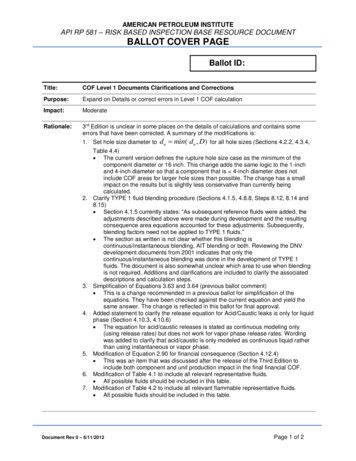
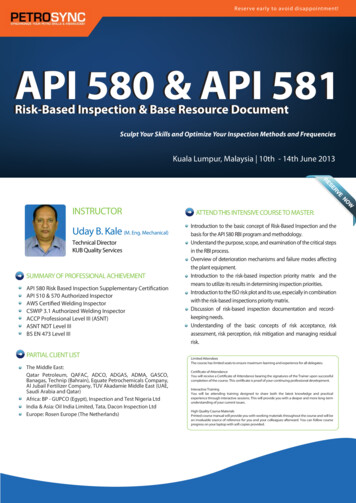
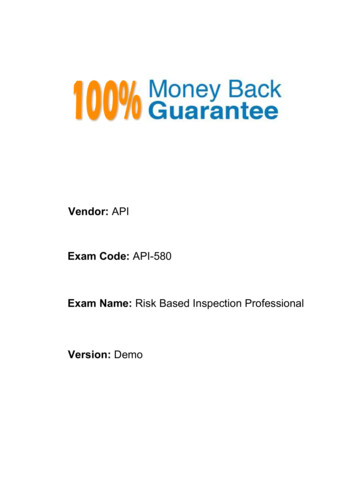
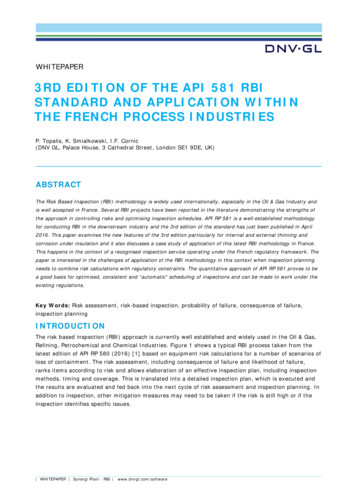
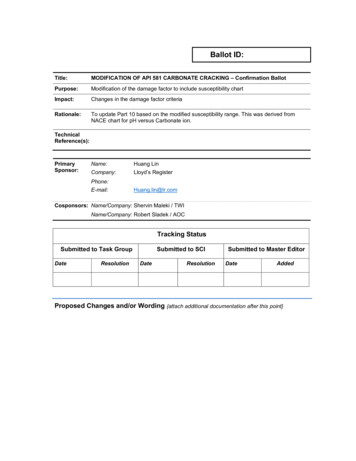
![API Ballot: [Ballot ID] – API 510 & API 570, Deferrals, Rev05](/img/5/api510andapi570deferralsrev5.jpg)
